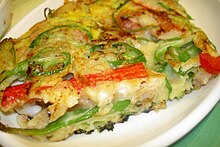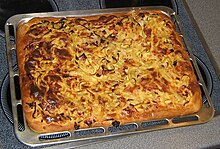Onion cake
 Sugar onion cakes | |
| Type | Savoury or sweet cake |
|---|---|
| Associated cuisine | China, Germany, Korea, Switzerland, Wales |
| Main ingredients | Onion |
| Ingredients generally used | Other cake ingredients |
| Variations | Laobing, pajeon, the scallion pancake, teisen nionod and zwiebelkuchen |
Onion cake is a savory or sweet cake prepared using onion as a primary ingredient. Various onion cakes are consumed in Canada, China, Germany, Korea, Switzerland, Wales and other countries. Several types and varieties of onion cakes exist, including laobing, pajeon, the scallion pancake, Edmonton-style green onion cake, teisen nionod and zwiebelkuchen.
Overview
Onion cake is prepared using onion as a main ingredient along with other typical cake ingredients.[1][2][3] The use of boiled onion can reduce the sharpness of the onion's flavor in onion cake.[3] Potato or bacon may also be used as a main ingredient in onion cake.[4][5][6][7] Additional ingredients can include cottage cheese[7] and sour cream.[8] Various onion cakes are consumed in China, Germany, Switzerland, Wales and in other countries.[3][5][9][10][11]
In Chinese cuisine, onion cake may be prepared using spring onion,[12] (also referred to as scallion). A basic Chinese onion cake can consist of flour, lard, spring onion and salt.[12]
Varieties
Edmonton-style green onion cake
A variant of the Chinese spring onion pancake popularized by chef Siu To has become the local specialty of Edmonton, Canada. Two variations exist: one with a typical pancake shape, and the other with a hole in the middle. To attributes the early popularity of his green onion cakes with the large number of Taiwanese expatriates in the area.[13]
Laobing

Pajeon
Pajeon is a savory jeon (pancake) dish in Korean cuisine prepared with a batter of flour, eggs and green onions or leeks.[18][19] Rice flour may also be used, along with additional ingredients, such as seafood,[20] pork and beef. Dongnae pajeon is prepared using green onion and seafood.[21]
-
Haemul pajeon is a variety of pajeon in Korean cuisine made with flour, scallion and seafood
Scallion pancake
A
Teisen nionod
Teisen nionod is a Welsh onion cake prepared with onion, potato, butter, beef stock, salt and pepper.[10][23]
Zwiebelkuchen
Zwiebelkuchen is a German onion cake or tart prepared with steamed onion, bacon, cream and caraway seeds on leavened or yeast dough.[24][25]
-
Zwiebelkuchen baked in a sheet pan
-
Deep-dish style Zwiebelkuchen
See also
References
- ISBN 978-0-547-34638-0.
- ^ Baking Industry. Clissold Publishing Company. 1922. p. 486.
- ^ ISBN 978-1-78131-466-1.
- ISBN 978-1-4088-4649-0.
- ^ ISBN 978-1-939629-44-9.
- ISBN 978-1-59210-426-0.
- ^ ISBN 978-1-4185-7473-4.
- ISBN 978-0-06-204688-8.
- ^ "Swiss review of world affairs". Volumes 21–24. 1971.
Normally about 40 tons of onions are sold on this single day, usually in attractively designed strings, wreaths and other more exotic shapes. There is also onion cake, onion soup and dancing in the streets. This year Bern's Onion Festival takes ...
- ^ ISBN 978-0-86243-315-4.
- ISBN 978-1-4290-1110-5.
- ^ ISBN 978-1-317-84620-8.
- ^ "How did green onion cakes become one of Edmonton's favourite foods?". CBC. Canadian Broadcasting Corporation. Retrieved 30 November 2020.
- ISBN 978-1-4613-1175-1.
- ISBN 978-0-7627-9040-1.
- ISBN 978-981-232-997-4.
- ISBN 978-0-8248-1493-9.
- ^ Stone, M. (2014). Traditions of South Korean Cooking: Learning the Basic Techniques and Recipes of the South Korean Cuisine. Martha Stone. p. pt76.
- ISBN 978-1-910496-24-4.
- ISBN 978-1-74104-774-5.
- ISBN 978-0-7614-1786-6.
- ^ ISBN 978-0-8118-7870-8.
- ISBN 978-0-231-13110-0.
- ISBN 978-1-61212-426-1.
- ISBN 978-0-313-32400-0.



